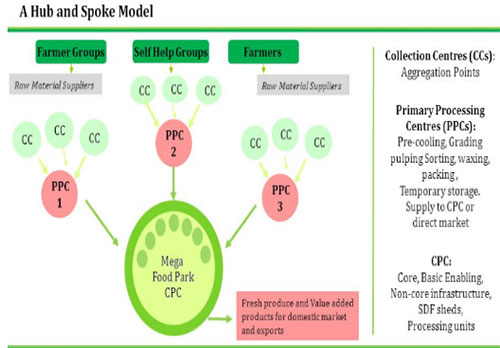(HOT) UPSC Current Affairs 2025 PDF
NEW! The Gist (NOV-2025) | E-BOOKS
Mega Food Park Scheme: Important Topics for UPSC Exams
Mega Food Park Scheme: Important Topics for UPSC Exams
 What
is the scheme all about?
What
is the scheme all about?
- It is a scheme of the Ministry of Food Processing Industry (MOFPI) of the Government of India and is an inclusive concept.
- It proposes a demand driven/pre-marketed model with strong backward/forward linkages and sustainable supply chain.
- Its objective is to establish a "direct linkage from farm to processing and then to consumer markets" through a network of collection centres (CCs) and primary processing centres (PPCs) so as to ensure optimization of value addition, minimization of wastage, increasing farmer’s income and creating employment opportunities particularly in rural sector.
- The scheme is based on a “Cluster” approach and envisages a well-defined agriculture or horticultural-processing zone containing state-of-the art processing facilities with support infrastructure and a well-established supply chain.
What are the highlights of this scheme?
- The financial assistance is provided in the form of grant-in-aid at 50% of eligible project cost in general areas and at 75% of eligible project cost in the North East Region and difficult areas (Hilly States and ITDP areas) subject to maximum of Rs.50 crores per project.
- 42 food processing units are expected to be operational within next 2 years out of which 8 are currently established and functional.(As of Oct. 2016)
- Collective investment of companies is expected to be at least 250 crores.
- A turnover of 400-500 crores and employment generation of at least 30000 from each mega food park is expected.
- Government has accorded an “infrastructure category” status to the project through this scheme so as to provide incentive for further investment and attract foreign investment.
What are the key objectives of the scheme?
- Increase processing of perishable items from 6% to 20%
- Increase India’s share in Food Processing Industry from 1.5% to 3%
How will it impact our society?
-
Economic Impact: Cost reduction of final processed food, employment creation, better sales figure of farmers, Infrastructure development.
-
Social Impact: Rising farm income will lead to less suicidal tendency and incidents among farmers; rise in income level of rural India will help in better health and education opportunities especially for women and children.
Make in India: Food Processing Industries will give impetus and fuel to this project. -
Ease of Doing Business: Availability of raw material will increase and faster delivery of goods will lead to better business opportunities.
-
Food Security: Waste Management and Reduction will improve net food items in the country which can be utilized under NFSA (National Food Security Act) and therefore minimization of imports will take place.
-
Environmental: Better and efficient supply chain models will lead to less trucks/vehicles on the road therefore less pollution and ultimately helping India in achieve its INDC (Intended Nationally Determined Contribution) under Paris Climate agreement.
-
Rural Development: Since the model is supposed to work near collection centres therefore rural areas will experience industrial development along with agricultural and horticultural development.
Conclusion
Mega Food Park scheme is very promising for rural development and integration of rural and urban India through various supply chain linkages. However, the working of the scheme in the last decade paint a different story due to cost overrun, delayed projects and litigated projects. Since land is a state subject therefore success of such scheme is possible only if there is acooperative federalism and land issues are resolved outside of the court.

